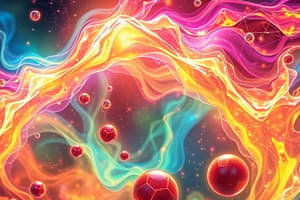Podcast
Questions and Answers
Which factor influences the formation of chemical bonds by determining the type and strength of the bond?
Which factor influences the formation of chemical bonds by determining the type and strength of the bond?
What type of chemical bond involves the sharing of electrons between atoms?
What type of chemical bond involves the sharing of electrons between atoms?
In which type of chemical bond do atoms transfer electrons, resulting in ions with opposite charges?
In which type of chemical bond do atoms transfer electrons, resulting in ions with opposite charges?
What is a combination of covalent and ionic bonding, involving a partial transfer of electrons?
What is a combination of covalent and ionic bonding, involving a partial transfer of electrons?
Signup and view all the answers
Which type of bonding involves electrons shared in an extended network of atoms?
Which type of bonding involves electrons shared in an extended network of atoms?
Signup and view all the answers
In metal compounds, what often makes their bonding complex?
In metal compounds, what often makes their bonding complex?
Signup and view all the answers
What type of bond is described as a direct chemical bond between two metal atoms?
What type of bond is described as a direct chemical bond between two metal atoms?
Signup and view all the answers
In coordination complexes, the bonding between metal ions and ligands is best described as:
In coordination complexes, the bonding between metal ions and ligands is best described as:
Signup and view all the answers
Which geometry can a coordination complex exhibit based on the arrangement of ligands around the central metal ion?
Which geometry can a coordination complex exhibit based on the arrangement of ligands around the central metal ion?
Signup and view all the answers
What is the study of the arrangement of particles in crystalline solids known as?
What is the study of the arrangement of particles in crystalline solids known as?
Signup and view all the answers
Which application of inorganic chemistry focuses on the synthesis of semiconductors for electronic devices?
Which application of inorganic chemistry focuses on the synthesis of semiconductors for electronic devices?
Signup and view all the answers
What does inorganic chemistry primarily study in relation to atoms and their interactions?
What does inorganic chemistry primarily study in relation to atoms and their interactions?
Signup and view all the answers
Study Notes
Exploring Inorganic Chemistry: The World of Chemical Bonding
Inorganic chemistry, a vast and intriguing branch of chemistry, deals with the study of all non-carbon-based elements and compounds. This field is rooted in our understanding of chemical bonding, the forces that hold atoms together to form molecules and ions. Let's dive into the fascinating realm of chemical bonding in inorganic chemistry.
Types of Chemical Bonds
Chemical bonding in inorganic chemistry primarily consists of four major types of bonds:
- Covalent bonds: The sharing of electrons between atoms.
- Ionic bonds: The transfer of electrons between atoms, leading to the formation of ions with opposite charges.
- Covalent-ionic bonds: A combination of covalent and ionic bonding, where there is a partial transfer of electrons.
- Metallic bonds: Electrons sharing in a large, extended network of atoms.
Bond Formation and Strength
The formation of chemical bonds is influenced by several factors, including the relative electronegativity and ionization energies of the elements involved. These factors help determine the type of bond, its strength, and the geometry of the molecule or ion formed.
Bonding in Metal Compounds
Metal compounds, such as metal oxides and metal salts, are ubiquitous in inorganic chemistry. Their bonding can be quite complex, often involving multiple bond types and overlapping effects.
- Metal-metal bonds: Direct chemical bonds between two metal atoms, such as those found in the compound Mg2+ (magnesium ion).
- Metal-ligand bonds: Chemical bonds between metal ions and ligands (atoms, ions, or molecules that donate electrons to the metal ion).
Coordination Complexes
Coordination complexes are compounds that consist of a central metal ion surrounded by various ligands. The bonding in coordination complexes can be described as dative covalent bonds, where electron pairs are transferred from the ligand to the metal ion. The geometry of the complex can be tetrahedral, square planar, octahedral, or other shapes, depending on the number of ligands and their orientations around the central metal ion.
Crystal Structures and Bonding
The descriptive study of the arrangement of particles (atoms, ions, or molecules) in crystalline solids is known as crystallography. The bonding patterns in these structures can be quite varied, but they are ultimately determined by the same fundamental principles of chemical bonding.
Applications of Inorganic Chemistry in Our Daily Lives
Inorganic chemistry is essential to our daily lives and has numerous applications, such as:
- The production of metals, alloys, and ceramics for various industries, from construction materials to aerospace engineering.
- The development of catalysts, which play a crucial role in accelerating chemical reactions and reducing energy consumption.
- The synthesis of semiconductors, which are integral components of electronic devices such as computers, smartphones, and solar panels.
Summary
Inorganic chemistry, in essence, is the study of the interactions between atoms and the bonds that result from these interactions. Exploring this field reveals the fundamental principles that govern chemical bonding, allowing us to understand, explain, and manipulate the world around us. Inorganic chemistry enriches our understanding of the chemical world and provides the foundation for numerous applications that improve our living standards and technological advancements.
Studying That Suits You
Use AI to generate personalized quizzes and flashcards to suit your learning preferences.
Description
Test your knowledge on the diverse world of chemical bonding in inorganic chemistry, exploring various bond types, factors influencing bond strength, metal compounds, coordination complexes, crystal structures, and real-world applications of inorganic chemistry. Enhance your understanding of the essential principles that govern chemical interactions and bond formation.




